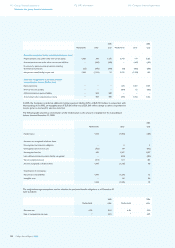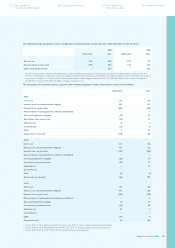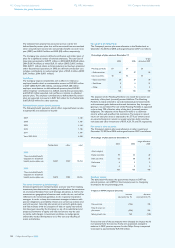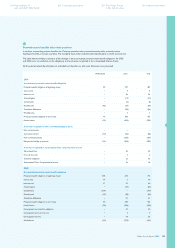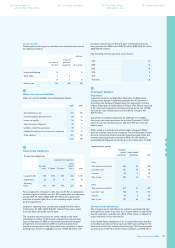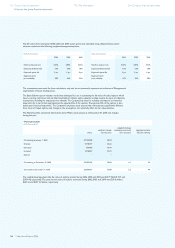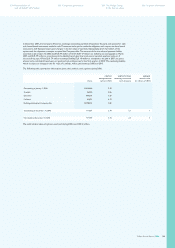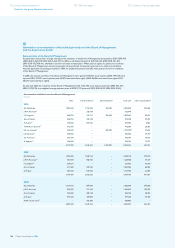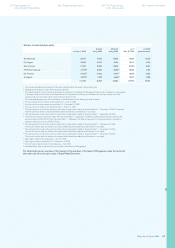Philips 2006 Annual Report Download - page 158
Download and view the complete annual report
Please find page 158 of the 2006 Philips annual report below. You can navigate through the pages in the report by either clicking on the pages listed below, or by using the keyword search tool below to find specific information within the annual report.
Philips Annual Report 2006158
‘Accounting for Contingencies’, and accrues for losses associated with
environmental obligations when such losses are probable and
reasonably estimatable.
Generally, the costs of future expenditures for environmental
remediation obligations are not discounted to their present value
since the amounts and the timing of related cash payments are not
reliably determinable. Potential insurance recoveries are recognized
when recoveries are deemed probable.
Litigation
Royal Philips Electronics and certain of its Group companies are
involved as plaintiff or defendant in litigation relating to such matters
as
competition issues, commercial transactions, product liability (including
personal injury claims for asbestos product liability), participations and
environmental pollution. Although the ultimate disposition of asserted
claims and proceedings cannot be predicted with certainty, it is the
opinion of the Company’s management that the outcome of any such
claims, either individually or on a combined basis, will not have a material
adverse effect on the Company’s consolidated fi nancial position, but
could be material to the consolidated results of operations of the
Company for a particular period.
Provided below are disclosures of the more signifi cant cases:
Asbestos
Judicial proceedings have been brought in the United States, relating
primarily to the activities of a subsidiary prior to 1981, involving
allegations of personal injury from alleged asbestos exposure. The
claims generally relate to asbestos used in the manufacture of
unrelated companies’ products in the United States and frequently
involve claims for substantial compensatory and punitive damages.
At December 31, 2006, there were 4,370 cases pending, representing
9,020 claimants (compared to 3,984 cases pending, representing 8,082
claimants at December 31, 2005, and 2,909 cases pending, representing
6,028 claimants at December 31, 2004). Most of the claims are in cases
involving a number of defendants. During 2006, 1,140 cases, representing
2,930 claimants, were served against the Company’s subsidiaries
(2,052 cases, representing 3,283 claimants, were served in 2005, and
2,436 cases, representing 4,085 claimants were served in 2004). While
management believes there are meritorious defenses to these claims,
certain of these cases were settled by the subsidiaries for amounts
considered reasonable given the facts and circumstances of each case.
A number of other cases have been dismissed. During 2006, 754
cases, representing 1,992 claimants, were settled or dismissed
(977 cases, representing 1,229 claimants, were settled or dismissed
in 2005, and 608 cases, representing 810 claimants, were settled
or dismissed in 2004).
In addition to the pending cases discussed above, a subsidiary of the
Company was one of approximately 160 defendants initially named in
a case fi led in August 1995 in Morris County, Texas. Since the time the
case was brought in 1995, the subsidiary had not been involved in any
substantive activity in the case other than fi ling an answer to the
complaint and had no information concerning the types of alleged
diseases or injuries involved. In the fourth quarter of 2005, plaintiffs’
counsel in this matter fi led information concerning the alleged
diseases and injuries with the Court. The claims have been severed
into four cases: one case with 281 malignant disease claims; two cases
with an aggregate of 222 nonmalignant disease claims with alleged
impairment; and one case with 3,167 claims that have no impairment
at this time. The cases with the malignant disease claims and
nonmalignant disease claims with alleged impairment are currently
pending in Morris County. The case containing the claims that have no
impairment at this time has been transferred to Harris County, Texas.
In accordance with SFAS No. 5, an accrual for loss contingencies is
recorded when it is probable that a liability has been incurred and the
amount of such loss contingency can be reasonably estimated. Prior
to the third quarter of 2006, this subsidiary established an accrual for
loss contingencies with respect to asserted claims for asbestos
product liability based upon its recent settlement experience of similar
types of claims, taking into consideration the alleged illnesses in
pending cases. For fi led claims where the exact type and extent of the
alleged illness was not known, the subsidiary established the accrual
for loss contingencies based upon a ‘low end of the range’ estimate
using the average settlement experience for claims alleging only less
severe illnesses (i.e. non-malignancy). At December 31, 2005 and 2004,
the subsidiary’s recorded accrual for loss contingencies with respect
to asserted claims for asbestos product liability amounted to EUR 88
million and EUR 83 million, respectively, which is refl ected in the
Company’s consolidated balance sheet.
An accrual for loss contingencies with respect to unasserted claims for
asbestos product liability was not established prior to the third quarter
of 2006 since the Company, with the assistance of a third party expert
with substantial experience in valuing and forecasting asbestos liabilities
(“the Third Party Expert”), concluded it could not reasonably estimate
this liability in accordance with SFAS No. 5 due to the subsidiary’s
limited historical claims experience coupled with the uncertainties
surrounding asbestos litigation and legislative reform efforts.
In the third quarter of 2006, the Third Party Expert reviewed the
subsidiary’s history of, among other things, claims and diseases alleged,
and claims settled or dismissed in order to provide the subsidiary with
an estimate of the volume, timing and cost of both current and future
asbestos-related personal injury claims. In light of additional claims
history experienced by the subsidiary, as well as the impact of state
tort reform in several states, the clarifi cation of the possibility of
national legislation and other factors, the Third Party Expert was able
to use a conventional methodology for estimating future asbestos-
related personal injury claims to provide a projection of the
subsidiary’s liability for pending and unasserted potential future
asbestos-related claims for the period from 2006 through 2016.
The methodology used to project the subsidiary’s total liability for
pending and unasserted potential future asbestos-related claims relied
upon various assumptions and factors, including the following:
An analysis of the subsidiary’s pending cases, by type of injury, and
an allocation of unknown injuries based on the empirical
experience of the subsidiary;
An analysis of data generated from a conventional model used to
project future asbestos claims for mesothelioma and lung cancer;
An analysis of the correlations between lung cancer fi ling rates and
the rates for other cancers and non-malignancy claims;
Epidemiological studies estimating the number of people likely to
have developed asbestos related diseases;
An analysis of average claim payment rates and mean payment
amounts by injury for claims closed in 2005 and 2006;
An analysis of the period over which the subsidiary has and is likely
to resolve asbestos-related claims against it in the future; and
An assumed infl ation rate of 2.5%, reduced by 1.5% to refl ect lower
claim valuations due to the aging of the claimant population.
According to the study prepared by the Third Party Expert, as of
September 25, 2006, the estimated cost of disposing of pending and
estimated future asbestos-related claims fi led through 2016, excluding
future defense and processing costs, totaled USD 507 million (EUR
396 million). The study also found that estimates based upon other
calibration metrics, none of which were considered more reliable than
the metrics used, were narrowly grouped within 6 percent in excess
of this projection. Approximately 19 percent of the estimated liability
relates to pending claims and approximately 81 percent relates to
future claims. As a result, in accordance with SFAS No.5, the subsidiary
increased its accrual for loss contingencies related to asbestos
product liability to this amount, which represents the undiscounted
estimate of indemnity costs for claims asserted through 2016, without
taking account of any potential insurance recoveries. This resulted in
a pre-tax charge to earnings of EUR 334 million for 2006 (a pre-tax
charge of EUR 18 million and EUR 54 million was recorded in 2005
and 2004, respectively). At December 31, 2006, the subsidiary’s
recorded accrual for loss contingencies for asbestos product liability
amounted to EUR 378 million, which is refl ected in the Company’s
consolidated balance sheet.
The estimate of the subsidiary’s liability for pending and unasserted
potential claims does not include future litigation and claim
administration costs. During 2006, the subsidiary incurred asbestos
litigation and claim administration costs totaling EUR 12 million (EUR
12 million in 2005 and EUR 10 million in 2004).
•
•
•
•
•
•
•
112 Group fi nancial statements
Notes to the group fi nancial statements
172 IFRS information 218 Company fi nancial statements




